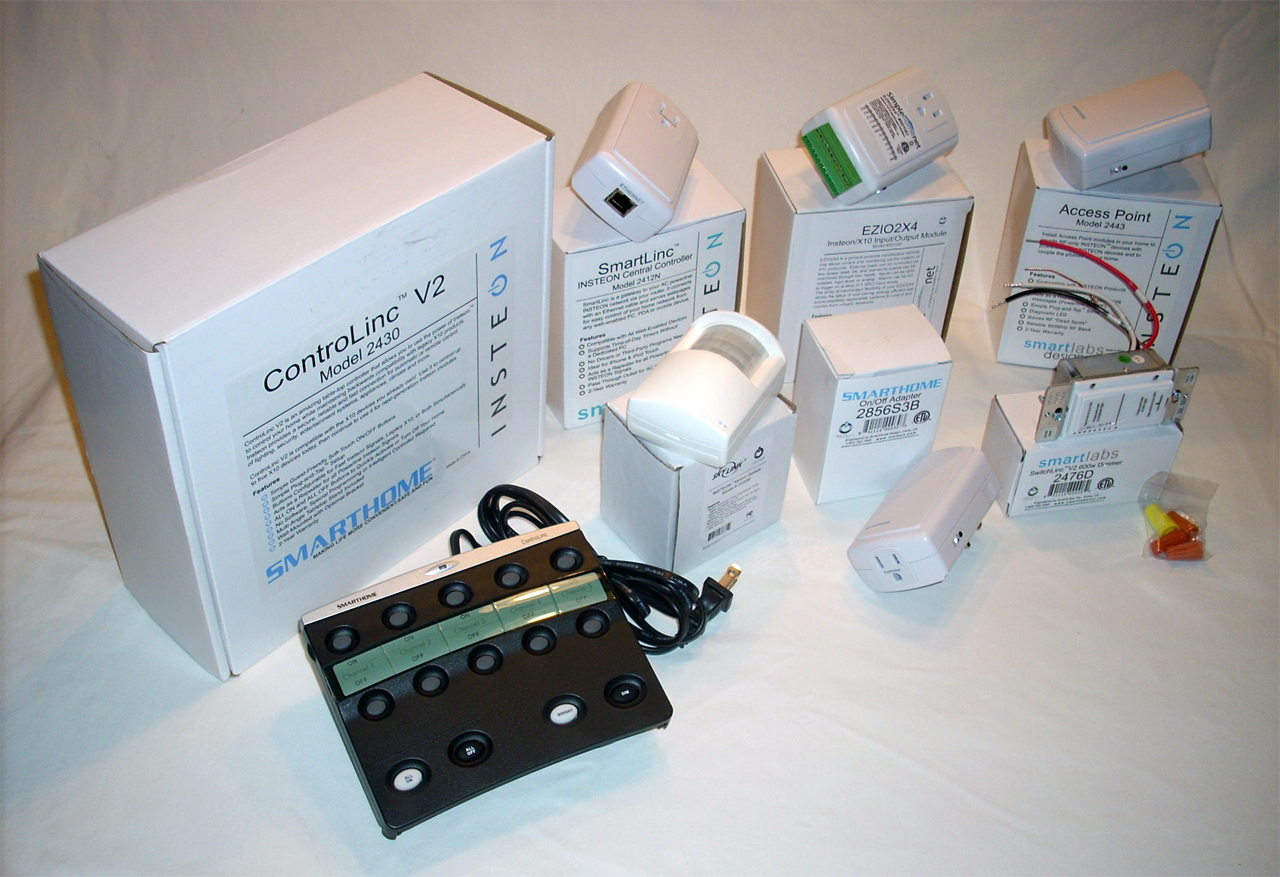Reader's Voice: An Introduction To Home Automation
The Hardware Arrives
At long last, the box of parts arrives.
Here is everything, unpacked and out on display:
Clockwise from the bottom right, we have a dimmer switch, a plug-in lamp controller, a motion detector, the table-top controller, the Smartlinc controller, the EZIO input/output controller, and an access point.
The starter light kit I ordered came with two dimmer switches, two access points, and the table-top controller. That kit is enough to get your feet wet with HA, but I wanted to experiment a bit more with the I/O controller and the motion detector, plus I wanted to be able to control the system from my iPhone. I also wanted to have a movable plug-in controller. The access points are used to tie the system together by bridging the wireless and wired signals, and bridging the electrical phases in your home. Another good use for them is to “jump” over electrical sinks like GFI circuits that have a tendency to absorb the transmitted signals.
The easiest kit to get started with comes with a wireless remote control, two access points, and two plug-in lamp controllers. With this, you won't have to do any of the difficult wiring. Of course, I was never one to go the easy route. So lets get to the fun part!
Get Tom's Hardware's best news and in-depth reviews, straight to your inbox.
Current page: The Hardware Arrives
Prev Page Off To The Store: Shopping For HA Next Page Installation: The Fun Part?-
Gin Fushicho Sounds like a lot of fun, though my Grandpa wouldnt like it , he likes to work too much. =/ He might like setting it up though.Reply -
Twoboxer IMO, the problem with "Home Automation" is thatReply
(a) it's fragmented
(b) most applications can be accomplished in most homes with less expensive, individual systems than with any integrated system - even if one existed.
HVAC: Unless you have a large home requiring multiple HVAC zones/thermostats, and unless parts of the home are unoccupied for varying amounts of time, a programmable thermostat is an adequate solution. Setbacks (eg while you are at work) don't seem to save much money with modern HVAC systems in most US climates.
Lighting: If "security" means cycling lights so the house looks occupied, again simple timers are adequate. Unless you have a large, multi-source lighted home, few need automated lighting and "scenes".
Irrigation: If you have any sprinkler system, once again timers and rain sensors do the job well enough.
And so on.
FYI, I have a large primary residence with a networked security system that also controls multiple thermostats. A dedicated PC has replaced a stand-alone DVR to monitor security cameras. A low-voltage, microprocessor controlled system controls lighting.
If these 8-year old systems talked to each other well, maybe I could use the motion detectors to automatically turn lights on and off. And maybe I wouldn't be better off using standard internet cameras to monitor security as I travel between homes.
Its all cool technology, but as a substantial user and tech-lover, I just don't see significant, practical application in most homes. -
Twoboxer Please forgive the double-post, but I couldn't resist pointing out one savings I learned about from all of this.Reply
I use a lot of 130V bulbs in the fixtures controlled by microprocessor controlled lighting system. Most of these bulbs are also oversized for their purpose, and are therefore set to run at, eg, 60% or 75% of maximum voltage when turned on.
I don't know whether I've saved any electricity or not - I doubt it lol - but I have saved a tremendous amount of money on bulbs. EG, there are 11 such bulbs in my kitchen ceiling and they run a minimum of 12 hours per day. I have not replaced a bulb in that set since they were installed over 8 years ago. -
mrubermonkey Buying proprietary systems is bad. Go with equipment that goes by industry standards and the whole issue with home automaton being a long-term investment goes away for the most part. Unless some company's proprietary technology always leads industry standards by leaps and bounds, but this is rare.Reply -
pratik77 If you want the real deal, go for Crestron.Reply
Sure it costs money but so does liquid nitrogen cooled overclocked gaming rigs. -
On the life of light bulbs . . . .Reply
Lamp life is very sensitive to operating voltage - for 120 volts Ge quotes 125 volts as shortening the lamp life to 1/2 and 130 volts to 1/3. The inverse is true - if you put a 130 volt lamp in a 120 volt circuit you can expect over double the lamp life, and if you have a dimmer to soft start then it can last a way lot longer.
http://www.gelighting.com/na/business_lighting/faqs/incandescent.htm -
How can you not mention http://www.CocoonTech.com, the largest DIY home automation site out there.Reply
-
sublifer cocoonerHow can you not mention http://www.CocoonTech.com, the largest DIY home automation site out there.It was mentioned on page 3:Reply
Many of the searches for further guidance landed me at cocoontech.com, and reading other people's guides and questions helped me through the process.

